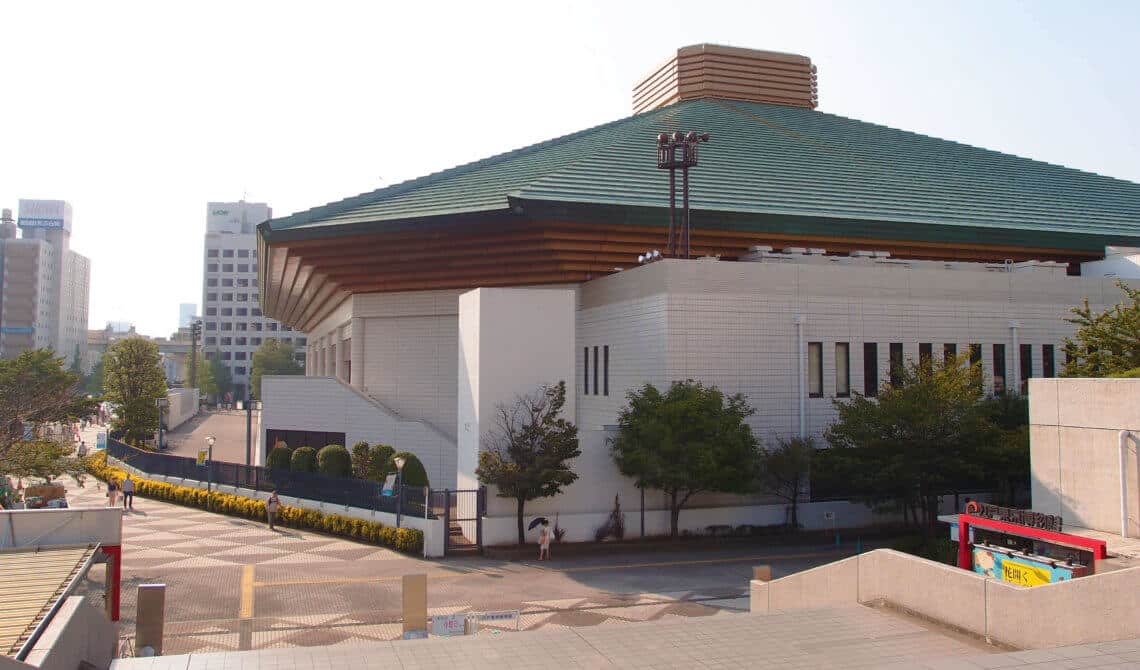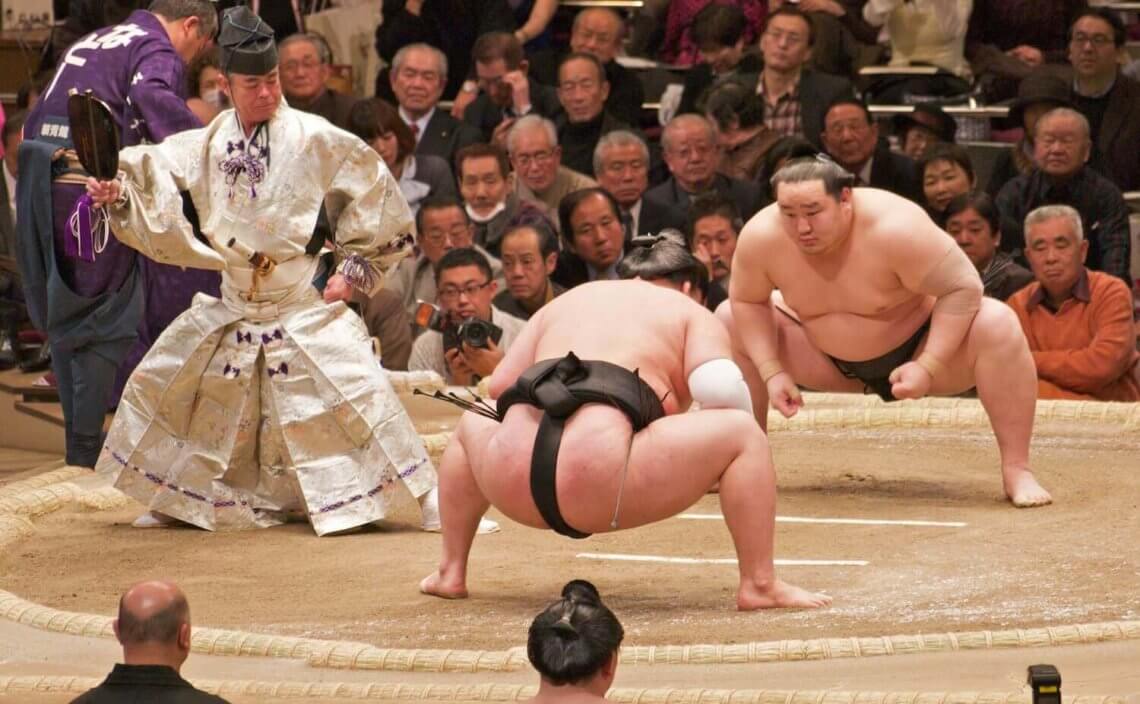Sumo is one of Japan’s most well-known sports, and a highly authentic Japanese cultural experience in and of itself.
But few would-be travelers to Japan know much about the ancient sport of sumo, so we’ve put together this simple guide to experiencing sumo in Japan.
If you’re interested in seeing sumo, and your travel dates are flexible, it’s worth going out of your way to attend a sumo basho (tournament) during your trip to Japan.
The only problem for travelers is that the tournaments only take place a few times a year, which means that for most travelers attending a basho ends up being impossible.
To help make sure this doesn’t happen to you, we’ve put together information on:
- When and where sumo tournaments take place
- How to buy basho tickets
- And where to sit!
Originally written in 2014, this post was updated and republished on May 21, 2019.

When & Where To See Sumo
The best way to experience sumo is by attending one of the official basho (sumo tournaments), which take place just six times each year in locations across Japan. For details read on!
There are other ways to experience sumo as well, such as by going to one of the sumo exhibitions held in between sumo tournaments, or by visiting a sumobeya, where the rikishi (wrestlers) live and train.
Morning Sumo Practice
If your travel dates don’t overlap with a sumo basho, attending a morning sumo practice can be a fun and fascinating option.
As you might imagine, sumo wrestlers wake up early, with lower-ranked rikishi starting earlier, and their higher-ranked colleagues joining in later in the morning.
Since sumobeya (often translated into English as “sumo stables”) are traditional spaces, expect to sit on the floor – and plan to be silent as you observe the massive yet agile rikishi engage in their morning ritual.
Visiting a sumobeya for morning practice is especially exciting, but for the quintessential sumo experience there’s nothing like attending a sumo tournament.
For information on non-tournament sumo events and exhibitions, consult the official Nihon Sumo Kyokai (Japan Sumo Association) website
Sumo Schedule: Basho Dates & Locations
The official sumo basho (tournaments) take place six times a year, beginning in January and then occurring every other month through November.
Three of the six sumo tournaments take place in Tokyo at the Ryogoku Kokugikan sumo arena, in Tokyo’s old-fashioned Ryogoku neighborhood, with the other three held in Osaka, Nagoya and Fukuoka.
Below is a list of each sumo basho, and where and when it takes place. Each tournament lasts for precisely 15 days (beginning and ending on Sunday), with the exact dates varying from year to year.
- January Tournament (Hatsu Basho): Tokyo
- March Tournament (Haru Basho): Osaka
- May Tournament (Natsu Basho): Tokyo
- July Tournament (Nagoya Basho): Nagoya
- September Tournament (Aki Basho): Tokyo
- November Tournament (Kyushu Basho): Fukuoka
For the exact dates of each basho, here is a link to the Japan Sumo Association’s official sumo schedule.

When attending a sumo tournament you have the option of sitting on traditional Japanese-style floor cushions, or in modern stadium-style chair seats.
For the full Japanese experience we recommend Japanese-style seating, though if you’re very tall or concerned about sitting on the floor (albeit on cushions) for relatively long periods of time, you may prefer to opt for the chair-style seating.
To help you decide, we’ve put together the essential details about each seating option below.
Floor Seats Vs. Chairs
There are 3 main categories when it comes to seat types at a sumo tournament:
- Japanese-style box floor seats
- Arena-style chair seats
- Ringside floor seats
As ringside sumo tickets are not generally available to the public, we’ll focus on the most common types of seats: Japanese-style floor seats and western-style chair seats.

Japanese-style Boxes (i.e., Floor Seats)
Japanese-style seating can be perfect if you’re looking for a completely Japanese experience. You remove your shoes and sit Japanese-style on floor cushions within a small designated “box” area.
The Japanese-style boxes also provide a great vantage point from which to witness the action, as all floor seats are a bit closer to the action than the arena-style chair seats.
One thing to be wary of when it comes to box-style seating is that the space is quite small, so even though most boxes are designed to accommodate 4 people, many people opt to split these 4-person boxes between just 2 people. If you’re tall — or simply want enough room to stretch out your legs a bit — then this is a great idea, as it can make things much more comfortable.
Fewer Clients, Richer Experiences
We live and breathe Japan, and want you to experience the Japan we know and love. If you’re as obsessed with the details as we are, chances are we will be a good fit.
It’s worth noting that Japanese-style sumo seating can be very uncomfortable for travelers with back or knee problems, or people not used to sitting Japanese style for extended periods of time.
Another important note is that, unlike arena seats, boxes are sold per box, not per person. They come in a variety of sizes, primarily designed for groups ranging from 2-4 people.
It’s not possible to buy an individual space in a box – you must purchase the whole box. They’re available in A, B and C categories, with A being the closest and C the furthest from the dohyo (the ring). Prices range from about 40,000 to 50,000 yen per box (divided by the number of people in your party).
Arena-style Chair Seats
If you’re hesitant to sit Japanese style as described above, then arena-style chair seating may be your best option.
In addition to the familiar comfort of a chair, these are also the least expensive seats at sumo tournament venues.
If there is a drawback, it is that they’re slightly further back from the action. However, basho venues are small enough that the dohyo is never too far (if you’re concerned about being able to see, bringing binoculars is a good idea).
Arena-style seats are available in A, B and C categories, with A being the closest and C the furthest from the dohyo. Prices range from about 4,000 yen to 10,000 yen.

Purchasing Sumo Basho Tickets
If you are planning a custom trip with us, we’ll make all the arrangements for you to attend sumo. But if you’re making the arrangements yourself, here is some key information to help you obtain sumo tickets.
The first and most important thing is, of course, to make sure your travel dates overlap with one of the sumo basho. The next step is to decide on your preferred type of seating and ideal budget for tickets.
If you know for sure that you’d like to attend a sumo basho, we highly recommend purchasing tickets in advance – in recent years, demand for sumo tickets has spiked dramatically.
Along with Japan’s increased popularity (meaning more travelers seeking tickets), interest among Japanese people has also increased with the first Japanese yokozuna (sumo champion) in many years (most yokozuna actually tend to be from other countries, such as Mongolia and Bulgaria).
Nowadays, sumo tickets tend to sell out almost immediately, with many being gobbled up by professional resellers. Weekends tend to be in highest demand, particularly each basho’s final weekend. If you’re not in Japan, one of the easiest ways to get sumo tickets in advance is through a company like BuySumoTickets.
Sometimes you can also purchase tickets at the sumo basho venue or at conbini (convenience stores) throughout Japan (at convenience stores the automated system is in all Japanese, so this option may require some patience!).
Sumo Tournament “Tours”
Even when tickets are likely to sell out, major tour companies in Japan — such as JTB — keep a limited stock of tickets and offer brief tours that include the chance to attend the basho.
While this can occasionally be a good backup option, please note that even these tours are in high demand and can sell out in advance.
Attending a Basho: It’s Tournament Day!
Assuming you’ve obtained sumo tickets, congratulations! The day has finally come for you to attend the basho.
Sumo is an all-day affair, but most spectators skip the morning matches and arrive in the mid-afternoon, when the higher-ranked rikishi (wrestlers) begin their matches.
If you arrive in the morning you’ll find a relatively empty venue, but you’ll be able to see some of the lower-ranked wrestlers going up against one another.
Unless you would like to spend the whole day at sumo, we recommend arriving in the mid afternoon. This is when the atmosphere begins to electrify, as the venue fills up and the best wrestlers begin their matches.
Make sure you’re seated well before 3:45 pm, when the crowd comes alive as the makuuchi (top wrestlers) enter the ring. At 4:00 pm, the yokozuna (grand champion) enters the ring, and the most exciting bouts commence.
The climax takes place when the two highest-ranked wrestlers face off in the concluding match right around 6:00 pm (5:30 pm on the basho’s final day). If you’re attending sumo make sure to be there for this part of the day, but it’s best to experience at least 1-2 hours of matches beforehand to get a more complete sumo experience.
Beer, Sake & Snacks
The sumo experience would not be complete without some snacks and drinks (whether you favor cold draft beer, sake, or Japanese whisky.
It’s almost a tradition to have a few drinks while watching sumo, though certainly not a requirement. You can also preorder special bento boxes to enjoy at the event.

Looking for more authentic Japanese experiences?
We hope our guide to seeing sumo helps you make the most of your Japan trip!
If you are looking to embark on a once-in-a-lifetime trip to Japan, we have resources that can help.
Start by checking out our sample Japan travel itineraries and learning about our process of crafting customized trips for travelers seeking unique, authentic experiences.


